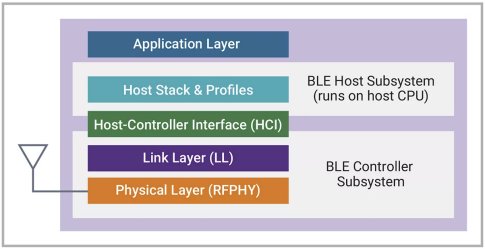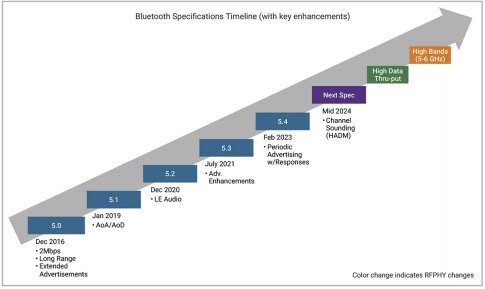By Charles Dittmer, Sr Product Manager, Synopsys
Synopsys is now shipping support for Bluetooth® 5.4, the latest specification from the Bluetooth SIG (Special Interest Group). The enhancements in Bluetooth 5.4 will open additional markets and use cases. This is one of the many inflection points in the Bluetooth Low Energy market that will be discussed in this paper.
One thing I have learned over my entire career in delivering multiple wireless products is that the world never stands still. Continued advancements in silicon technology, enhancements to the various wireless standards and the continuous leapfrogging of the technology providers drives us all to constantly re-evaluate how and who we select for technology sourcing.
These technology sourcing decisions can be traced back to inflection points that occur in the market or to technology advancements and enhancements. This article will specifically focus on Bluetooth Low Energy (*) or “BLE” by examining the following 3 types of inflection points in the BLE market:
- Continued additions of BLE enhancements via the release of new Bluetooth specifications.
- The shift in Make vs Buy decisions by the various silicon providers.
- The advent of upcoming BLE enhancements driving changes in vendor sourcing decisions.
(*) Originally BLE was branded as “Bluetooth Smart” but use of this name has all but disappeared.
Continued additions in BLE enhancements
The Bluetooth SIG is celebrating its 25th year anniversary this year and Bluetooth, specifically BLE, is alive and well and continuing to evolve. As seen in Figure 1 below, annual shipments continue to grow at a CAGR of 9% with over 5 billion units expected to ship in 2023, and a forecasted annual shipment of well over 7 billion by 2027. It is important to note that platform shipments remain basically flat during this 10-year timeline. Platform devices are things we usually call “host” devices such as PCs, tablets and mobile phones. To stay compatible with legacy Bluetooth peripheral devices in the field, these platforms almost always support both the older Bluetooth BR/EDR or what we call “Bluetooth Classic,” as well as the newer Bluetooth Low Energy protocol.
The most notable trend is that all the growth is in peripheral devices. These devices are primarily “BLE only” and are mainly driven by both BLE’s low power characteristics for battery-powered devices as well as new enhancements being added to the BLE feature set.

Figure 1: Bluetooth Platform & Peripheral Device Shipments
Historically, a new Bluetooth specification has been released about every 1.5 to 2 years, with each specification release usually containing three to four new enhancements. These features may range from minor improvements to major step functions driving significant growth opportunities or “inflection points.” Let’s look at the more significant changes in Bluetooth specifications:
- 2010- Bluetooth 4.0: This was the most significant change since Bluetooth inception back in 1998. This added what we now call Bluetooth Low Energy, a totally different protocol than the original Bluetooth Classic. BLE was fundamentally designed around the use of 3-volt coin batteries to power IoT devices and sensors. BLE has been so well adopted that the last specification update to older Bluetooth Classic was made back in 2014 in the BT4.2 release. All enhancements to the Bluetooth specification added since then have been made specifically for Bluetooth Low Energy.
- 2016- Bluetooth 5.0: This consisted of three enhancements, the most significant being the addition of a 2Mbps mode (formally limited to 1Mbps) and Long-Range modes (up to 4x the range) enabled by “Coded PHYs” via the use of forward error correction.
- 2020- Bluetooth 5.2: This was coined as a “game changer” as it added LE audio (audio over BLE) which previously was only supported by the older, point-to-point Bluetooth Classic protocol. This provided significant power savings for BLE audio devices such as headphone and ear buds, increased audio quality, and enabled “broadcast” audio (one-to-many) which the BT SIG has recently branded as Auracast™.
- 2023 – Bluetooth 5.4: This consisted of four enhancements, with the most notable being Periodic Advertising with Responses (PAwR) and to a lesser degree Encrypted Advertising Data (EAD). These features were primarily driven by Electronic Shelf Labeling or ESL. I consider this as an inflection point compared to other specifications because this is creating an entirely new market for BLE as the ESL vendors move from propriety wireless protocols to standardizing on BLE. There are several other applications for PAwR, which some are calling the new BLE Mesh since the original BT5.1 Mesh specification from back in 2017 hasn’t seen a significant adoption rate. There are also uses for PAwR in automotive applications such as e-vehicle Battery Management Systems (BMS) and Tire Pressuring Monitoring Systems (TPMS) that will be built into the actual tire itself.
So what are the next inflection points for Bluetooth Low Energy? We look forward to three significant enhancement that are currently being defined in the working groups.
- Channel Sounding or High-Accuracy Distance Measurement (HADM). This feature is expected to be released in 2024 and enables the creation of locating systems that can provide even higher levels of accuracy/positioning. There is also a strong pull from automotive applications such as digital keys.
- Higher Data Throughput is another attractive enhancement that is a bit further out in time. The intent is to increase the current 2Mbps throughput rates up to 6-8 Mbps. This will address applications requiring higher performance/streaming larger media, gaming, and even higher quality audio.
- Higher Frequency Bands, which is even further out in time, defines the operation of BLE in additional unlicensed mid-band spectrums such as the 5-6 GHz frequency band. This will alleviate some of the wireless congestion currently in the 2.4GHz frequency band as well as improve latency.
The last section of the paper will discuss how these upcoming enhancements will change the complexion of Bluetooth sourcing decisions.
Make vs buy
Every silicon vendor is challenged with the decision to either design various functional blocks of their SoC in-house or license existing design blocks of “IP” (Intellectual property) from 3rd party suppliers. Most all silicon vendors license several IP blocks to build their SoC. This includes CPU cores, interconnect systems, memory controllers, security elements, and a variety of wired interfaces. Why should BLE be any different?
When it comes to Bluetooth IP, we have seen a significant uptake in the last couple of years from silicon vendors making the decision to license already proven BLE solutions vs. expending their expensive internal engineering resources to design it in-house. This is yet another inflection point in delivering BLE devices to market.
Synopsys has BLE design wins for our RFPHY (radio) and Link Layer Controller from several tier 1 silicon vendors who have been in the BLE business for several years. Why is that?
The are several factors driving the trend to “buy” or license BLE IP.
- BLE is becoming ubiquitous. Whether it is used as the primary wireless interface or to provide wireless access to a device for set-up, provisioning and maintenance, BLE has quickly become just another standard interface on SoCs.
- As discussed in the previous section, new BLE standards will continue to be released, and it is has become more and more expensive to maintain an internal design team to keep up with all of the new enhancements.
- Moore’s law is certainly in play. Porting RF/Analog designs to smaller geometries to maintain a competitive edge in die area (cost) and power consumption is very expensive. Many of the internal solutions from established BLE vendors have not kept up with these topology shifts and remain physically large and power hungry.
- Available BLE Radio IP, like the Synopsys solution, is approaching theoretical limits on size, power consumption, and performance metrics such as receive sensitivity (i.e. -100dBm @1Mbps). This makes it difficult to justify spending internal resources only to meet the specifications that are already available at a lower cost.
- On the other side are start-up companies who have limited funding. It takes three or more years and 1000’s of person-months to build up a capable BLE design team for the analog radio, digital modem and controller, and the host software stack to comply with the BLE protocol specifications.
- There is another group of silicon vendors who may have been in the business for several years with non-wireless solutions but, because of the ubiquity of BLE, are adding it to their SoC for the very first time and lack the RF knowledge to do so internally.
Whatever the reasons or criteria you might have for doing a ”Make vs Buy” analysis it is certain that there has been a recent inflection point in sourcing BLE solutions by shifting to licensing from 3rd party IP solutions.
Upcoming BLE enhancements will drive changes in vendor sourcing decisions
I have already spoken about new BLE enhancement on the near horizon, starting with the new specification planned for mid-2024 supporting Channel Sounding. To appreciate this discussion, we must first look at the various layers in a “BLE Stack” that create a full BLE solution.
The full BLE stack can be broken down to almost a dozen separate levels or functions but, in its simplest form, there are three basic elements as shown in Figure 2. These are the three IP blocks usually licensed by 3rd party BLE IP vendors.

Figure 2: Bluetooth Low Energy Stack
- Attached to the external antenna is the lowest part of the stack, which is the physical layer called the “PHY” (shown in orange). In BLE language as defined by the Bluetooth SIG, this is called the RFPHY. It consists of both the analog radio (or transceiver) as well as digital logic in the PHY that supports functions such as modulation, demodulation, frequency control, calibration and other functions.
- The next layer is called the Link Layer Controller. This is similar to the “MAC” that is used in OSI based wireless standards like WiFi, Thread, Zigbee and others. The Link Layer serves as the pathway for the digital data transmission coming out of or going into the RFPHY. The Link Layer Controller manages the link state of the radio, schedules packet reception and transmission, guarantees the delivery of data and other radio control procedures in managing the link.
- The Host SW Stack and Profiles run on the Host CPU within the SoC along with the application code. It is comprised of multiple transport and network protocols allowing applications to communicate with other devices. You might also note that there is an interface between the Host SW Stack and the Link Layer Controller which is conveniently called the Host/Controller Interface or simply the “HCI”. This is both a physical and logical interface that is non-timing dependent. The communication protocol across the HCI is defined in the Bluetooth specification, which allows for fairly easy integration and compatibility between Host SW Stacks and Link Layer Controllers from different vendors.
The inflection point changing vendor sourcing decisions can be found in the details of the upcoming Bluetooth specification. Figure 3 shows the various Bluetooth Standards from BT5.0 in 2016 to the planned enhancement over the next 3-4 years.

Figure 3: Bluetooth Specification Timeline
Enhancements added in the BT5.0 through BT5.4 specifications affected either the digital Link Layer and/or the Host SW stack. This required changes to digital logic or software but it did not affect the RFPHY design. The net result is the RFPHY used to support BT5.0 remained unchanged through BT5.4.
The game changer going forward is each of the major upcoming enhancements shown will require design modifications to the RFPHY and the Link Layer that controls it.
As noted in Figure 2, the Link Layer Controller and the RFHY together create something that the Bluetooth SIG defines as the “Controller Subsystem”. This is because the RFPHY and the Controller are tightly coupled to form this sub-system. How the Controller and RFPHY work together to support these new features is very critical and can be time dependent. Unlike the HCI interface, there is no defined standard as to how the RFPHY and Link Layer Controller interact with each other. This creates a fairly time consuming and iterative integration process adding significant risk in supporting these new standards if you source the RFPHY and Link Layer Controller from two different 3rd party IP vendors. There will certainly be some incompatibility across vendors creating a pause for concern if this married pair is not sourced from a single vendor.
Synopsys is actively working on all of the new and upcoming Bluetooth specifications and will support them in the time frame of their release.
Our RFPHYs and Link Layer Controllers have industry leading power, performance and area (PPA) specifications. Sourcing both the RFPHY and Link Layer Controller from Synopsys will greatly reduce the risk in supporting these new Bluetooth enhancements. To learn more, visit: www.synopsys.com/bluetooth or contact your local Synopsys sale representative to get started.
